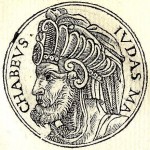So how can the kingdom be both present and future? What was Jesus trying to say?..."
The rest of the chapter is a study of four men (two of them who lived before Jesus and two who lived after Jesus). By looking at the careers of these four leaders of Israel, Wright is showing how this present-and-future tension was a common reality. The four men are:
 |
| Judah Maccabeus, "The Hammer" |
2. Simon bar-Kosiba ("Simon the Star") who rose to leadership in AD 132, just about 100 years after Jesus' public career.
3. Herod Antipas ("Herod the Great") who was placed in power as the "King of the Jews" by Rome in 40 BC.
4. Simon bar-Giora who appeared at another time of social and political chaos when the great revolt against Rome's rule started in AD 66, ending in the Temple's destruction in AD 70.
For the sake of brevity, I will look only at the first of these leaders, Judah the Hammer, as an example of the "present-and-future" tension commonly at work in these leaders. (Wright's study of the other three is very interesting and is further support for the point he is making about Jesus' kingdom.)
The crucial period of Judah's career was a 3-year campaign that ended in a triumphant entry into Jerusalem and a cleansing of the Temple. It was Syria that was the enemy; Syria's king, Antiochus Epiphanes, had desecrated the Temple by rededicating it to the god Zeus; he attempted to crush the resistant spirit of the Jews by forcing them to eat pork, thereby breaking their sacred law. Judas was the figurehead leader of the Hasmonean family which led the resistance movement. He waged a 3-year guerrilla war at the end of which he purged the Temple of the pagan elements. (It is this victory that the Jews celebrate each year in the festival of Hanukkah.)
Judah's victory "sharpened up the ancient story line: the wicked tyrant oppressing God's people, the noble and heroic leader risking all, fighting the key battle, cleansing the Temple, and setting Israel free to follow God and his law once more. This was the story of Moses, Egypt, and the Exodus. It was the story of David, Solomon, the Philistines and the Temple. It was the story of Babylon overthrown, of return from exile...Some people believed it had all come true in and through Judah and his brothers..."
However, with the passing of time, the reality that prophecies had not been fulfilled and utopia had not arrived with Judah's victory began to dawn on the people. The fact was that the Hasmonean family were themselves far from perfect as rulers of the Jews. And so pressure groups, most famously the Pharisees, arose to try to force the issue. The Pharisees were deeply loyal to their understanding of ancient traditions and fervently expected God to act once more. So once again, when Jesus of Nazareth appeared on the scene about 200 years later, the hopes and prayers of the people had all the elements of Israel's dream: the wicked rulers, the people's suffering, the hero, the battle, the victory, the rule over surrounding nations, the establishment of God's dwelling.
The author's point in exploring the careers of leaders on both sides of Jesus historically is to clarify two things about Jesus' public career: first, that there was always a "well-recognized set of expectations for a 'king of the Jews,' with roots extending all the way back to the Exodus...victory over the pagans and cleansing or rebuilding the Temple were high on the list" of the expectations.
 |
| Model of Temple built by Herod the Great |
The second thing clarified by examining these leaders is it was expected that any such campaign would have at least two "'key moments': first, the time when the flag was raised, and then the moment when the final battle was won and the Temple was rebuilt. Such movements would expect to live between these two moments, between an initial announcement and a final victory."
David exemplifies this in his being anointed as king long before he was finally enthroned..."Once we learn to think the way Jews of the time thought and indeed take into consideration the real political situation (rather than just a set of religious ideas or beliefs), the idea of a kingdom that is both emphatically present and emphatically future is not a problem..."
All of the 4 characters in this chapter had two major parts to their kingdom agenda: the battle(s) they fought or hoped to fight, and the Temple they cleansed or rebuilt or hoped to rebuild. "What did Jesus do with those great interlocking themes of the battle and the victory on the one hand, and the building or cleansing of the Temple (the place of God's presence) on the other?"
Chapter 10 answers this question about these great themes of battle and the Temple.

No comments:
Post a Comment